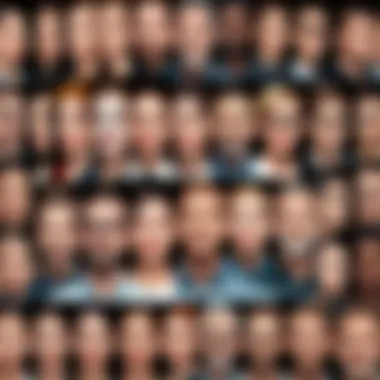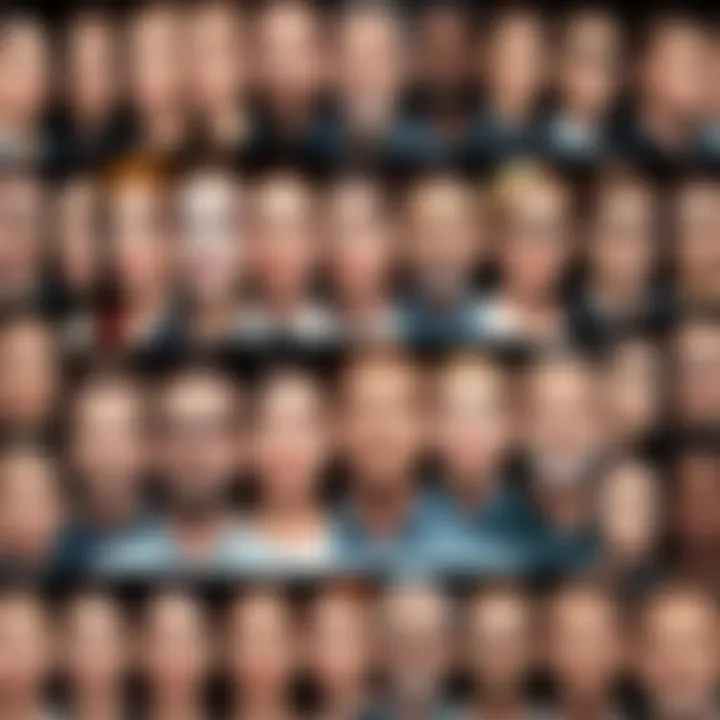The Impact of Face Swap Apps on Modern Filmmaking


Intro
The integration of technology in film has transformed the way stories are told. One of the latest advancements in this sector is the rise of face swap applications. These tools allow filmmakers to manipulate faces in real-time, leading to innovative storytelling and creative visualization. Film directors and editors now have the ability to experiment with character casting and visual effects in ways that were previously limited by budget and practical constraints. As this technology evolves, it presents various implications and challenges that are worth examining.
Overview of the Technology
Face swap applications leverage sophisticated algorithms and artificial intelligence to modify facial features in movies. These applications can seamlessly blend one actor's face with another, allowing for various practical applications in the film industry.
Key Specifications
- AI-driven Algorithms: Most face swap apps deploy neural networks to analyze and replicate facial movements with high accuracy.
- Real-time Processing: This capability allows filmmakers to preview the changes as they happen, streamlining the editing process.
- Multiple Platform Compatibility: These apps often support integration with multiple platforms, such as mobile devices and professional editing software.
Unique Selling Points
Face swap applications present distinct advantages for both filmmakers and audiences.
- Cost-Efficiency: They reduce the need for extensive makeup or prosthetics by digitally altering faces.
- Enhancing Storytelling: Certain scenes might be enriched by altering characters dynamically.
- Creative Flexibility: Directors can experiment with alternate castings without the need for reshoots.
"The ability to swap faces in real-time opens up new creative avenues for filmmakers that were once constrained by physical limitations."
Design and Build Quality
The effectiveness of face swap applications also hinges on their design and usability.
Material Used
While a software application doesn't have physical materials in the traditional sense, the underlying programming and framework are critical. These applications often utilize programming languages such as Python or C++ to build their core functionalities.
Ergonomics and Usability
- User-Friendly Interface: Most successful face swap applications prioritize user experience, ensuring that even those with limited technical knowledge can navigate effectively.
- Customization Options: Applications often allow users to fine-tune facial features, providing greater control over the final outcome. By offering a variety of effects and parameters, these tools invite creativity while maintaining simplicity.
Understanding these aspects is crucial for filmmakers, technologists, and consumers in today's media landscape. As face swap technology develops, its potential will expand, and so too will the discussions surrounding its use in ethics and storytelling.
Prelude to Face Swap Technology
The introduction of face swap technology marks a significant evolution in the realm of visual effects in filmmaking. This technology allows creators to superimpose a person’s face onto another's body, leveraging computer algorithms that provide new creative avenues. By integrating face swap applications, filmmakers can not only enhance visual storytelling but also streamline processes that may have been cumbersome or resource-intensive in the past.
The importance of this technology stems from its ability to generate a seamless connection between the viewer and the narrative. With face-swapping capabilities, characters can be more dynamically represented, and diverse casting choices become less of a constraint. For instance, an actor can portray multiple characters through digital manipulation, enabling filmmakers to approach storytelling with a fresh perspective.
Moreover, the rise of face swap technology has prompted discussions about authenticity and representational integrity within cinema. As artists explore this technology, they must also grapple with its implications on identity and originality. Therefore, examining the technical and ethical aspects of face swap applications is essential for understanding its impact on modern filmmaking.
Definition of Face Swap Technology
Face swap technology fundamentally refers to the digital process of exchanging faces between individuals in video and still images. Utilizing algorithms, this technology can analyze facial features, emotions, and expressions to create a realistic transition that mimics the original footage. Typically, this is achieved through machine learning models that train on datasets rich with facial variations.
The core functionality involves detecting key facial landmarks and re-mapping them onto another's face, maintaining congruity in movements and expressions. This process offers multiple applications beyond entertainment, appearing in fields like advertising, gaming, and even education.
Historical Context and Development
The concept of face manipulation is not entirely modern. It has roots in early photography and film techniques, where artists would use practical effects for character transformations. However, the integration of digital technology has dramatically shifted the paradigm.
In the early 2000s, advancements in computer graphics and machine learning began paving the way for realistic face swaps. The term "deepfake" emerged as neural networks and artificial intelligence took center stage in the manipulation of visual media, combining vast data sets for more nuanced outcomes. As tools like Adobe After Effects and more recent software became accessible, creators started experimenting with face swapping, leading to explosive growth in this niche.
Today, face swap apps are widely available across various platforms. From mobile applications that allow users to create light-hearted edits to sophisticated software used in film production, the scope of this technology has broadened significantly. These tools have empowered content creators to push boundaries, explore new storytelling dynamics, and challenge established norms within cinematic presentation.
Technical Foundations of Face Swap Applications
The technical foundations of face swap applications are pivotal in understanding their role in modern filmmaking. By dissecting how these applications function, one can appreciate their profound impact on the narrative and visual aspects of cinema. A comprehensive grasp of the technology not only unravels the intricacies behind successful implementations but also highlights the advantages and potential pitfalls associated with using face swap applications.
Machine Learning Algorithms


Machine learning algorithms serve as the bedrock of face swap technology. These algorithms are designed to analyze vast amounts of data, learning from patterns and improving their accuracy over time. They allow for the precise replacement of facial features by studying characteristics such as skin tone, expression, and angles. This capability is essential to achieve realism in the final output.
One of the prevalent algorithms used is Generative Adversarial Networks (GANs). GANs consist of two neural networks that work against each other to generate realistic images. The first network creates images, while the second evaluates them, offering feedback. This interplay results in progressively more refined outputs, making it ideal for face swapping.
Deepfake Technology Explained
Deepfake technology is another significant contributor to the functionality of face swap applications. It relies on deep learning to create hyper-realistic alterations of faces in videos. By utilizing extensive datasets of images and videos, deepfake systems can generate convincing results. This technology can seamlessly integrate one person's facial expressions onto another individual's facial structure without visible discrepancies.
This aspect also raises concerns about authenticity, particularly in storytelling. The convincing nature of deepfakes challenges conventional perceptions of reality, especially in cinematic contexts.
"Deepfakes represent a significant shift in how audiences perceive on-screen authenticity."
Real-time Processing Capabilities
Real-time processing is a crucial feature of advanced face swap applications. It enables immediate feedback and adjustment, which is particularly valuable during filming. This capacity allows filmmakers to see face swapping effects applied live, granting more control over performances and visual presentations.
With improved computing power and optimized algorithms, real-time face swap applications can now operate on standard hardware. This accessibility means that even indie filmmakers can explore elaborate effects without extensive budgets. The advancement of mobile devices has further expanded this capability, allowing filmmakers to implement these effects on set.
In summary, the technical foundations of face swap applications encompass machine learning algorithms, deepfake technology, and real-time processing capabilities. Each of these components contributes essential elements that enhance visual storytelling in film. Understanding these foundations is crucial for filmmakers seeking to push the boundaries of creativity while navigating the accompanying ethical and practical challenges.
Applications of Face Swap in Filmmaking
Face swap technology has taken on a significant role in the film industry, facilitating a myriad of applications that enhance storytelling and character interactions. This section delves into how filmmakers leverage these innovations to create captivating narratives and visually stunning effects, ultimately reshaping the filmmaking process itself. Understanding the practical aspects of these applications is essential for any interested party in this field, from filmmakers to tech enthusiasts.
Character Development and Replacement
In traditional filmmaking, character development relies heavily on actor performances and scriptwriting. However, face swap technology allows for unprecedented flexibility in character portrayal. Filmmakers can replace an actor's face with that of another individual, seamlessly integrating their features into a scene. This function not only provides the ability to create varied performances but also brings new dynamics to character interactions.
For instance, consider a film where a character needs to exhibit a range of emotions that the original actor may not convey. By applying face swap, directors can utilize another actor's facial expressions alongside the original performance. This blend can deepen character development and elevate the emotional impact of a scene. Furthermore, this technique permits casting decisions that may not have been feasible before, adding diversity to cast selections without compromising the narrative fidelity.
Visual Effects Enhancement
Face swap technology complements visual effects by offering a level of realism that traditional effects often struggle to achieve. In films that require extensive VFX, such as fantasy or sci-fi genres, combining face swap with CGI can create immersive experiences that captivate audiences. This blending allows for more lifelike movements and interactions, preserving the subtleties of human expression that are often lost in purely digital creations.
Moreover, integrating face swap enhances the overall aesthetic of a film. Whether it's creating a character who can morph into different identities for narrative purposes or providing a backup face for stunts, the possibilities are vast. The technology streamlines workflows for visual effects artists, enabling quicker iterations and refinements, thus expediting the post-production process while maintaining high-quality output.
Reviving Classic Characters
One of the most intriguing applications of face swap technology is its potential in reviving iconic characters from the past. Through digital face replacement, filmmakers can give new life to beloved characters in sequels or remakes without needing to cast new actors. This approach raises questions of nostalgia and audience attachment—bringing back familiar faces can evoke strong emotions, enriching the viewing experience.
Several films, such as Rogue One: A Star Wars Story, have successfully implemented this technology to recreate characters who have long been absent. By using archival footage and modern face swap techniques, filmmakers can maintain the essence of classic portrayals while creating new narratives. However, this application also requires careful consideration of ethical implications and audience expectations as it straddles the line between innovation and potential overreach.
"The integration of face swap technology invites a realm of creativity previously unattainable in cinematic storytelling."
The Role of Face Swap Technology in Cinematic Storytelling
Face swap technology plays a transformative role in cinematic storytelling. It allows filmmakers to manipulate visuals in a way that can enhance narrative depth and intrigue. With the evolution of this technology, its importance in storytelling has increased significantly, offering numerous benefits alongside potential considerations that filmmakers must evaluate.
One of the core elements of narrative in film is the conveyance of emotion and character intent. Face swap technology can elevate this aspect by allowing actors to embody different characters, facilitating a more versatile performance. By swapping faces, filmmakers can create complex interactions among characters, adding layers to emotional scenes. This method of storytelling can shift the audience's perception and enhance their engagement with the film's plot.
Moreover, the technology provides filmmakers with opportunities for creativity that were not feasible before. Directors can experiment with imaginative scenarios. Characters can engage in dialogues with their own counterparts, or even appear as another character entirely. This not only fascinates the viewer but also serves as a powerful tool for narrative exploration.
"Face swap technology is not just a gimmick; it is an innovative approach to storytelling in modern cinema."
However, there are significant ethical considerations to keep in mind. The authenticity of performances may be questioned when technology alters facial appearances. Fluctuating audience reception may challenge the creativity of film narratives by introducing skepticism toward digitally altered performances. Balancing these factors is essential for filmmakers aiming to harness the potential of face swap technology for storytelling.
Enhancing Narrative Techniques
Face swap technology enhances narrative techniques by enabling filmmakers to manipulate characters in ways that deepen the storytelling experience. By using this technology, we can explore complex character relationships and develop richer plots. One effective use is in flashbacks or dream sequences, where characters can reflect experiences or emotions by swapping faces with others.
This allows for a rapid shift in the audience’s perception, creating surprising twists that keep viewers engaged. Additionally, face swaps can serve to represent internal conflicts visually. For example, a character dealing with a moral dilemma may swap faces with an antagonist, visually symbolizing their struggle. This technique can make abstract concepts concrete, enhancing the audience's understanding of character motivations and conflicts.


Creating New Character Dynamics
The ability to swap faces creates new character dynamics, transforming how relationships are portrayed on screen. By allowing characters to take on faces of others, filmmakers can create unique interactions that would otherwise be impossible. This can result in unexpected alliances, conflicts, and humor. Characters may embody traits or personas of others, enabling a fresh perspective on their interactions.
Furthermore, this manipulation can bridge generational gaps or cultural differences within narratives. For instance, a character from one era could assume the face of a widely recognized historical figure, leading to dialogues that resonate with contemporary issues or provide social commentary. The result is a thought-provoking narrative that challenges viewers’ perceptions and evokes a deeper connection to the storyline.
In summary, face swap technology is a powerful tool for cinematic storytelling. Not only does it enrich narrative techniques and create dynamic character interactions, but it also raises important ethical questions that filmmakers must navigate. As technology advances, its implications for the film industry will continue to evolve, requiring careful consideration and creative application.
Ethical Considerations in the Use of Face Swap Technology
The incorporation of face swap technology in filmmaking raises essential ethical questions. This section aims to dissect the moral implications tied to this innovative tool, focusing on consent and intellectual property issues. Understanding these ethical considerations is vital for filmmakers and technologists to responsibly use these technologies in their projects.
Consent and Intellectual Property Issues
Consent is a primary concern when utilizing face swap technology. This process often entails manipulating an individual’s likeness without their explicit permission. In many instances, actors may find their faces digitally altered in ways they did not authorize. This poses significant ethical dilemmas regarding personal autonomy and rights over one’s own likeness.
Furthermore, intellectual property laws are complex when it comes to digital representations of individuals. Often, filmmakers must navigate a legal landscape that may not adequately cover the nuances of face-swapping technology. For example, using the image of a deceased actor can lead to unpredictable legal challenges. Filmmakers must ensure that they obtain the rights to use someone’s likeness, which may include obtaining licenses or agreements from the individuals or their estates.
Impact on Audience Perception
The use of face swap technology can significantly alter how audiences engage with films. Audiences may find themselves questioning the authenticity of what they are watching. Concerns arise when viewers wonder if the depicted characters genuinely represent the actors they are familiar with. When altering faces, filmmakers risk losing the emotional connection that the audience establishes with original portrayals.
"The capacity to influence viewer perceptions makes it essential for filmmakers to consider how their use of technology will shape narratives and audiences' experiences."
Additionally, the potential for misuse is an alarming reality to consider. If audience members become aware that face swap technology can create misleading portrayals, it may undermine trust in cinematic storytelling. As a result, filmmakers must tread carefully, balancing creativity with ethical responsibility.
In summary, the ethical implications of face swap technology are profound. Consent and intellectual property issues, along with their impact on audience perception, must be addressed by those in the film industry. Acknowledging these ethical considerations ensures that face swap technology is used in a manner that respects individual rights while enriching viewer experiences.
Challenges Facing Face Swap Applications in Film
Face swap applications, particularly in film, represent an intriguing frontier in cinematic technology. However, their adoption does not come without significant challenges. These challenges can impact how filmmakers utilize these tools, shaping the landscape of modern cinema. Careful consideration of technical limitations and societal perceptions is necessary to understand their full implications.
Technical Limitations and Constraints
One major challenge is the technical limitations inherent in face swap technologies. Although advancements in machine learning and deepfake technologies have improved results, several hurdles persist. For instance, the need for high-quality data sets remains critical. Poor-quality input images lead to unsatisfactory output, often resulting in unrealistic or jarring visual effects. Moreover, real-time processing can strain computing resources, limiting the feasibility of on-set applications during filming.
Inconsistencies in lighting and skin tones can also affect the accuracy of face swaps. If lighting conditions change between shots, the final product appears disjointed. Additionally, while some applications boast capabilities for seamless integration, they often fall short in maintaining the actor's expressions and gestures, essential for conveying emotion and authenticity. This disconnect can disrupt the viewer's immersion in the story.
Public Backlash and Misuse of Technology
Another pressing concern centers around public backlash and the misuse of face swap technology in film. As the complexity of these tools grows, so does the potential for misuse. Audiences may object to how these technologies alter narratives or create deceptive representations of actors. Creating deepfakes without consent raises serious ethical questions, impacting public perception of the film industry as a whole.
Many high-profile cases exemplify this challenge, where recognizable faces are manipulated in a context unintended by the original actors. The reaction from the public can be swift and unforgiving. Film studios may find themselves in a precarious situation, balancing creativity against possible outrage. Furthermore, if audiences feel manipulated or misled, their trust in filmmakers may wane, affecting box office performance.
"As technology advances, so too must our responsibility to use it wisely and ethically."
Ultimately, navigating these challenges demands thoughtful consideration by filmmakers. Understanding both the technical constraints and the societal implications of them is crucial for the ongoing evolution of face swap applications in film.
Future Trends in Face Swap Technology for Films
Understanding the future trends in face swap technology is essential for grasping its potential impact on the film industry. Movie makers are constantly seeking innovative ways to enhance storytelling, and face swap applications offer new avenues for creativity. As technology evolves, filmmakers can expect to find tools that not only simplify production processes but also enrich the viewing experience for audiences.
Advancements in Artificial Intelligence
Artificial Intelligence (AI) has been a driving force behind the improvement of face swap technology. Recent developments in deep learning algorithms significantly enhance the quality of facial recognition and image processing. As AI continues to advance, it will enable more precise face tracking and blending, allowing for a more seamless integration of different faces in any scene. This introduces the potential for increased realism, making it difficult for audiences to discern between original performances and altered ones.
Some anticipated advancements include:
- Improved Accuracy: Algorithms will become better at understanding facial gestures, lighting conditions, and even emotional expressions, leading to a more natural outcome in films.
- Dynamic Adaptation: Future models may allow face swaps to adapt in real-time to changes in the environment or during spontaneous scenes.
- User-Friendly Tools: Tools will likely become more accessible to indie filmmakers, enabling a broader range of creative expressions.
"The future of filmmaking lies in merging artistic vision with technological prowess."


Predicted Changes in Filmmaking Practices
As face swap technology becomes more advanced, traditional filmmaking practices will inevitably transform. Filmmakers will likely alter their approaches to casting, scene design, and visual storytelling. This could manifest in several key ways:
- Casting Flexibility: Face swap technology may allow directors to cast actors based on character suitability without limitations posed by physical appearance. This could lead to more diverse and inclusive representations in films.
- Reimagining Classic Roles: Filmmakers may explore reviving iconic performances by swapping the faces of contemporary actors onto the bodies of legendary talents from the past, creating new narratives while maintaining a connection to cinematic history.
- Interactive Storytelling: The rise of face swap applications could lead to audience participation in film narratives, allowing viewers to select characters or influence outcomes by swapping their faces into the storyline.
As these trends develop, the film industry must remain vigilant about the ethical considerations that accompany such innovations, ensuring that creativity does not compromise personal rights and artistic integrity.
Comparative Analysis: Face Swap Apps vs. Traditional Effects
In this section, we explore the crucial differences between face swap apps and traditional effects used in filmmaking. Understanding these differences is vital for filmmakers, as it influences not only production choices but also creative opportunities and overall film quality. Face swap apps employ advanced technologies such as artificial intelligence to manipulate video in ways that traditional methods cannot achieve. It brings an element of efficiency and innovation which can be game-changing in the industry.
Cost Efficiency of Face Swap Technologies
Cost efficiency is one of the standout advantages of face swap technologies over traditional effects. Traditional filmmaking techniques, such as prosthetics or on-set greenscreen work, often require significant investment in time and resources. For instance, creating a highly detailed mask takes skilled labor and costly materials. Additionally, the setup for shooting scenes can be complex, requiring specialized equipment and extensive location adjustments.
Face swap applications, however, can reduce these costs substantially. With the power of machine learning, filmmakers can generate realistic face swaps digitally. This not only streamlines the production process but often results in lower labor costs. The speed at which edits can be made is also impressive. A swap that might take days to perfect in a studio can often be adjusted in real-time using face swap technology.
- Data Handling: Face swap technology can manipulate existing footage, turning previous takes into new scenes. This capability permits filmmakers to use their resources more efficiently by maximizing footage already shot.
- Budget Overruns: Traditional methods frequently lead to budget overruns due to unforeseen challenges. Face swap apps help maintain a more predictable budget since updates can occur rapidly and with fewer external factors affecting production.
Creative Freedom and Flexibility
Creative freedom is a critical concern for filmmakers, and face swap technologies present significant advantages here as well. Unlike traditional special effects, which can be limited by physical constraints or technical skills of the crew, face swap applications can offer greater flexibility. Filmmakers can explore multiple creative avenues with ease.
For instance, directors can visualize different character portrayals without the need for reshoots. The ability to experiment with various actors' faces on a character can lead to unique storytelling possibilities. It opens doors for creative collaboration across various artistic styles without the traditional limitations of casting.
- Concept Development: This flexibility allows a filmmaker to iterate on concepts faster. If a script change requires a different character or actor portrayal, it can be seamlessly adjusted.
- Limitless Creativity: No longer bound by the physical limitations of traditional makeup and effects, the only barrier left is imagination.
"Face swap technology represents the intersection of art and technology, creating a space where creativity knows fewer bounds than ever before."
Case Studies of Successful Face Swap Implementations in Film
Case studies are vital for understanding the efficacy and impact of face swap technology in filmmaking. They provide a tangible context in which theoretical discussions about technology can be assessed. Exploring these case studies reveals how filmmakers leverage these tools to enhance storytelling and character development, showcasing the practical benefits and creative freedom that face swap applications offer.
This section will explore several notable films that utilized face swap technology, analyzing both their implementation and the broader implications for the film industry. These examples not only underscore the technical capabilities of the technology but also raise important questions about the ethical dimensions and audience reception.
Notable Films Utilizing Face Swap Technology
Several films stand out when discussing the innovative use of face swap technology. For instance, "Rogue One: A Star Wars Story" effectively utilized this technique to recreate the likeness of the late actor Peter Cushing as Grand Moff Tarkin. This example highlights how filmmakers can bring characters back to life through advanced visual effects, contributing to narrative authenticity while reviving beloved characters.
Another film worth mentioning is "The Irishman," directed by Martin Scorsese. The film employed face swap technology to de-age performances, allowing actors like Robert De Niro and Al Pacino to portray their characters across different ages seamlessly. This innovation demonstrated the potential not only for continuity in character portrayal across timelines but also for delivering a more comprehensive narrative arc.
These films represent a shift toward integrating cutting-edge technology into traditional filmmaking processes. The use of face swap applications not only changes how stories are told but also how audiences engage with these narratives.
Analysis of Reception by Critics and Audiences
The reception of face swap technology in films is nuanced and varied. Critics often praise the innovation and visual realism achieved through these applications. However, there are also apprehensions about the implications for authenticity and the potential for misuse. For example, while some hail the return of classic actors as a triumph of technological achievement, others argue that it raises ethical questions about consent—especially when representing deceased individuals.
Audience reactions also diverge. Many viewers appreciate the immersive experience enhanced by believable character portrayals, while others express discomfort regarding the manipulation of familiar faces. The conversation around audience perception is critical as it influences future choices by filmmakers regarding face swap technologies.
End: The Impact of Face Swap Apps on the Film Industry
Face swap applications represent a significant shift in the film industry, offering filmmakers a new avenue for creative expression. This technology not only streamlines traditional special effects but also reshapes viewer experiences. In this article, we explored various aspects of face swap technology, emphasizing what this means for the future of cinema. The intersection of technology and creativity has become increasingly relevant, as filmmakers seek innovative ways to engage audiences.
Final Thoughts on Technological Integration
The integration of face swap apps allows a dynamic approach to storytelling. Using these tools, filmmakers can modify characters or even resurrect past icons without the traditional constraints of casting and makeup. The likely consequence is a more enriched narrative, where characters can evolve fluidly with storylines. Adapting classic scenes with modern actors can lead to fresh interpretations. The real-time capabilities of most face swap applications further facilitate collaboration between directors, actors, and visual effects teams.
These technological integrations require firms to continually assess their production strategies. Filmmakers must also consider technical compatibility alongside the artistic vision. As this tech becomes commonplace, a balance between traditional methods and modern innovations will inevitably emerge.
Future Outlook for Filmmakers and Technologists
As face swap technology evolves, the potential applications in filmmaking are broad. One anticipated direction is the increased use of artificial intelligence in character likeness representation. Technologists are likely to push boundaries, enabling even more sophisticated likeness transfers that will obscure the lines between reality and fiction.
Moreover, filmmakers will benefit from easier access to these innovative tools. This democratization of technology opens doors for independent filmmakers, allowing them to produce high-quality content on smaller budgets. The film landscape may shift from the exclusive domain of major studios to a more collaborative and varied environment.
In summary, the ongoing evolution of face swap applications will continue to reshape the film industry's landscape while offering endless creative possibilities. The implications for storytelling and audience engagement are profound, suggesting that this is just the beginning.







